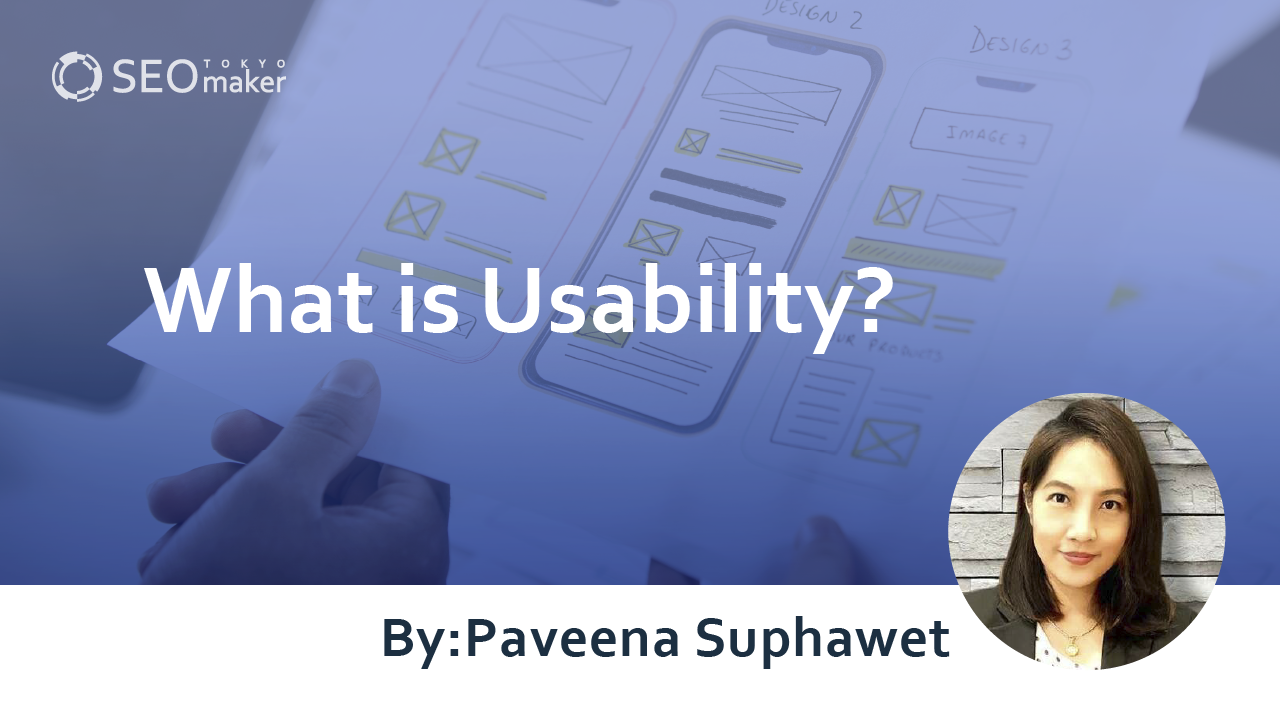What is Usability? Understanding Its Impact on SEO and Differences from Accessibility
contents

In the realm of website management, the term ‘usability’ often comes up. Usability, a term widely used, might be somewhat interpreted based on its feel by many. However, explaining usability can be challenging for some.
In the web industry, usability is crucial as it directly links to SEO (Search Engine Optimization). It’s important to understand usability deeply, not just superficially.
Here, we will explain the basics of usability, its relationship with SEO , and tips to enhance usability in web operations.
What is Usability?
Usability, a term derived from the English words ‘Use’ and ‘Able,’ generally refers to ease of use. Some standard definitions of usability include;
-International standard ISO 9241-11
-Proposed by Dr. Jakob Nielsen”
ISO 9241-11 and Usability Standards
ISO 9241-11 refers to the definition of usability set by the International Organization for Standardization (ISO).
This organization works on standardizing norms among nations, including defining usability. In Japan, this is expressed as the national standard JIS Z 8521 , defining usability as below;
“The degree to which a specific user can achieve certain goals effectively, efficiently, and satisfactorily under specific usage conditions. “
Dr. Jakob Nielsen’s Contribution
Dr. Jakob Nielsen, a Danish pioneer in usability research, defines usability in his book ‘Usability Engineering’ as follows
- Learnability: Easy to become familiar with and start working even for first-time users
- Efficiency: Once learned, it can be used efficiently
- Memorability: Easy to remember, even after not using it for a while, so no need to relearn
- Errors: Minimizes the occurrence of errors, easy recovery from errors, and prevents critical failures
- Satisfaction: Ensures user satisfaction, making it enjoyable and likable to use
(Source: Academy Plex)
Web Usability
Web usability refers to the convenience and ease of use of a website. Typically, visitors come to a website with a clear purpose, such as wanting to know something specific. Therefore, websites need to be designed to facilitate visitors in comfortably achieving their objectives.
For instance, if a visitor wonders where to find certain information on the site, having a well-structured navigation system enables them to accomplish their goal with minimal effort.
Difference Between Usability and Accessibility
Usability is often mentioned alongside accessibility. Both terms imply ease of use, but accessibility specifically refers to the ease with which people of all abilities and physical conditions can use something equally.
A website is considered highly accessible if it has the following features:
-It allows everyone, regardless of physical disabilities or age, to easily access the information they need.
For example, if a website has many elderly visitors, the small text may be difficult for them to read due to presbyopia. By increasing the text size to accommodate this audience, the website’s accessibility has improved.
Difference from UX
UX (User Experience) refers to the overall experience users have when interacting with a product or service, also known as the user experience.
Through this experience, users develop various emotions towards the service, including impressions of usability. Thus, usability is an aspect of UX.
Differences from UI
UI (User Interface) represents the point of interaction between the user and a product or service. In the context of websites, the UI is the screen display on a user’s device.
The UI encompasses the design and layout of a webpage, affecting how it is navigated and used. Therefore, there is a significant relationship between usability and UI.
Importance of Web Usability
Web usability refers to how user-friendly a website is. Low usability implies that visitors might have some dissatisfaction with the web pages.
Visitors are essentially customers for a website or page, and as service providers, websites must offer high-quality information and content.
Impact on SEO
Although web usability is not directly related to SEO, low usability can make visitors perceive the site as difficult to use. This perception can lead to the followings in web analytics.
-Increased instances of short page visit durations
-Low page navigation rates
-Low repeat visit rates
Particularly, if there is a rise in instances where visitors immediately leave after opening a page (browser back action), it could signal to Google that the page is of low value.
Thus, poor usability can ultimately have a negative impact on SEO, so it’s critical to be aware of this.
Causes of Low Web Usability
Factors contributing to low web usability include;
- Long page load and response times
- UI not reflecting the user perspective
- Insufficient internal linking
Long Page Load and Response Times
When page load times are long, it causes stress for site visitors. Additionally, a slow response to user actions can reduce the comfort of the site experience.
Be aware that if your website exhibits such issues, it could lead to an increase in visitors immediately leaving the page upon loading.
UI Not Reflecting User Perspective
Usability can decrease when the UI does not consider the user’s perspective. Poor placement of menu headers or ads can lead to difficult navigation and hinder content access.
For instance, a menu placed in a way that makes text hard to read shows the need to design UI from the visitor’s perspective.
Lack of Internal Linking
A scarcity or poor organization of internal links diminishes usability.
For example, visitors might leave the site to look up unfamiliar terms mentioned in an article.
Ways to Improve Usability
Improving usability can mainly be addressed by
-Checking Core Web Vitals
-Using web analytics
-Listening to user feedback
Checking Core Web Vitals
Core Web Vitals are metrics for a comfortable user experience on a website, including
-LCP (Load Time metric)
-FID (Page Response metric)
-CLS (Layout Stability metric)
These three Core Web Vitals metrics aim to enhance visitor UX. Low scores in these metrics indicate content that is difficult to use. Reviewing and addressing any issues in these metrics can lead to improved usability.
Using Web analytics
Utilizing web analytics tools allows you to check the history of your website. For instance, you can monitor data like;
- Trends in the number of visits
- Average time spent on the page (the average duration of a page view)
- Average pages per session (the average number of pages viewed per user)
If the duration of stays or pages per session is extremely low, it may indicate issues with the website such as;
- Long page loading times
- Poor page response
- Disrupted layout
- Difficult-to-navigate UI
- Insufficiently placed internal links
These issues could lead visitors to quickly leave the site, implying that they find the website difficult to use, hence not even browsing the content. To get an accurate evaluation of the content, first improving the website’s usability is essential.
Listening to User Feedback
Ultimately, usability is judged by how easy users find the website to navigate. Gathering feedback from actual site, visitors can shed light on specific improvements like, ‘This area could be enhanced in this way.’
Methods to collect visitor feedback include;
- Implementing comment features on pages
- Establishing contact points using email
- Listing SNS information for website management
- Conducting surveys with giveaways
Frequently Asked Questions about Usability
We’ve compiled common questions about usability in an FAQ format.
Q: Are there alternative terms for usability?
A: Generally, it refers to ease of use. It can also be expressed as below;
-User-friendliness
-Convenience
-Utility.
Q: What does high usability mean?
A: It means users can easily achieve their objectives without difficulty when using a product or service.
Conversely, low usability implies that users struggle to accomplish their goals.
Q: Should usability be considered when creating web pages?
A: Yes, considering usability enhances the quality of the user experience, potentially increasing repeat visits.
Q: Any tips for considering usability?
A: Create pages from a user’s perspective.
Consider who will use the page and why.
Comparing the page with others can also provide insights into the user’s view.
Q: Is there an abbreviation for usability?
A: There is no specific abbreviation for usability. Related terms include UI and UX, which have different meanings.
By the way, UI and UX stand for the following terms:
UI = User Interface
UX = User Experience
Summary
We view usability as the ease of use of products or services, which translates to how comfortably and efficiently a website can be browsed and information gathered. High usability leads to better SEO outcomes. If there are usability challenges on your website, review and refine internal settings and content creation from the user’s perspective.










![What is a Description? Explaining the Meaning, Writing Style, and Changing Word Count – [2023 Edition]](https://www.switchitmaker2.com/en/wp-content/uploads/2024/09/what-is-description.webp)










